Antibody data
- Antibody Data
- Antigen structure
- References [11]
- Comments [0]
- Validations
- Immunohistochemistry [4]
- Other assay [10]
Submit
Validation data
Reference
Comment
Report error
- Product number
- 14-9381-80 - Provider product page

- Provider
- Invitrogen Antibodies
- Product name
- Podoplanin Monoclonal Antibody (NZ-1.3), eBioscience™
- Antibody type
- Monoclonal
- Antigen
- Other
- Description
- Description: Podoplanin is a 40-kDa type I transmembrane sialomucin-like glycoprotein involved in platelet aggregation and cancer metastasis. This protein is expressed on lymphatic endothelial cells and follicular dendritic cells, as well as on many human cancers, including squamous cell carcinoma, glioblastoma, seminoma, and mesothelioma. Podoplanin expression has been demonstrated to be regulated by the Fos protein of the Activating Protein-1 (AP-1) transcription factor complex. Much of its functionality arises via interaction with its endogenous receptor, C-type lectin-like receptor-2 (CLEC-2). This antibody has been reported to block the interaction between Podoplanin and CLEC-2. Applications Reported: This NZ-1.3 antibody has been reported for use in immunoprecipitation, immunoblotting (WB), and immunohistology staining of paraffin embedded tissue sections. Applications Tested: This NZ-1.3 antibody has been tested by immunoblot analysis of U87 cells. This can be used at 1-5 µg per mL. It is recommended that the antibody be carefully titrated for optimal performance in the assay of interest. Purity: Greater than 90%, as determined by SDS-PAGE. Aggregation: Less than 10%, as determined by HPLC. Filtration: 0.2 µm post-manufacturing filtered.
- Reactivity
- Human, Rat
- Host
- Rat
- Isotype
- IgG
- Antibody clone number
- NZ-1.3
- Vial size
- 25 μg
- Concentration
- 0.5 mg/mL
- Storage
- 4°C
Submitted references Reprogramming bone progenitor identity and potency through control of collagen density and oxygen tension.
Dissecting human embryonic skeletal stem cell ontogeny by single-cell transcriptomic and functional analyses.
Directed induction of alveolar type I cells derived from pluripotent stem cells via Wnt signaling inhibition.
Kaposi's sarcoma-associated herpesvirus vFLIP promotes MEndT to generate hybrid M/E state for tumorigenesis.
Distinctive Properties of Endothelial Cells from Tumor and Normal Tissue in Human Breast Cancer.
T helper cells in synovial fluid of patients with rheumatoid arthritis primarily have a Th1 and a CXCR3(+)Th2 phenotype.
Functionally distinct disease-associated fibroblast subsets in rheumatoid arthritis.
Human Extravillous Trophoblasts Penetrate Decidual Veins and Lymphatics before Remodeling Spiral Arteries during Early Pregnancy.
Interaction among activated lymphocytes and mesenchymal cells through podoplanin is critical for a high IL-17 secretion.
CCL7 contributes to the TNF-alpha-dependent inflammation of lesional psoriatic skin.
CLEC-2 and Syk in the megakaryocytic/platelet lineage are essential for development.
Al Hosni R, Bozec L, Roberts SJ, Cheema U
iScience 2022 Apr 15;25(4):104059
iScience 2022 Apr 15;25(4):104059
Dissecting human embryonic skeletal stem cell ontogeny by single-cell transcriptomic and functional analyses.
He J, Yan J, Wang J, Zhao L, Xin Q, Zeng Y, Sun Y, Zhang H, Bai Z, Li Z, Ni Y, Gong Y, Li Y, He H, Bian Z, Lan Y, Ma C, Bian L, Zhu H, Liu B, Yue R
Cell research 2021 Jul;31(7):742-757
Cell research 2021 Jul;31(7):742-757
Directed induction of alveolar type I cells derived from pluripotent stem cells via Wnt signaling inhibition.
Kanagaki S, Ikeo S, Suezawa T, Yamamoto Y, Seki M, Hirai T, Hagiwara M, Suzuki Y, Gotoh S
Stem cells (Dayton, Ohio) 2021 Feb;39(2):156-169
Stem cells (Dayton, Ohio) 2021 Feb;39(2):156-169
Kaposi's sarcoma-associated herpesvirus vFLIP promotes MEndT to generate hybrid M/E state for tumorigenesis.
Chen W, Ding Y, Liu D, Lu Z, Wang Y, Yuan Y
PLoS pathogens 2021 Dec;17(12):e1009600
PLoS pathogens 2021 Dec;17(12):e1009600
Distinctive Properties of Endothelial Cells from Tumor and Normal Tissue in Human Breast Cancer.
Wilkus K, Brodaczewska K, Kajdasz A, Kieda C
International journal of molecular sciences 2021 Aug 17;22(16)
International journal of molecular sciences 2021 Aug 17;22(16)
T helper cells in synovial fluid of patients with rheumatoid arthritis primarily have a Th1 and a CXCR3(+)Th2 phenotype.
Aldridge J, Ekwall AH, Mark L, Bergström B, Andersson K, Gjertsson I, Lundell AC, Rudin A
Arthritis research & therapy 2020 Oct 16;22(1):245
Arthritis research & therapy 2020 Oct 16;22(1):245
Functionally distinct disease-associated fibroblast subsets in rheumatoid arthritis.
Mizoguchi F, Slowikowski K, Wei K, Marshall JL, Rao DA, Chang SK, Nguyen HN, Noss EH, Turner JD, Earp BE, Blazar PE, Wright J, Simmons BP, Donlin LT, Kalliolias GD, Goodman SM, Bykerk VP, Ivashkiv LB, Lederer JA, Hacohen N, Nigrovic PA, Filer A, Buckley CD, Raychaudhuri S, Brenner MB
Nature communications 2018 Feb 23;9(1):789
Nature communications 2018 Feb 23;9(1):789
Human Extravillous Trophoblasts Penetrate Decidual Veins and Lymphatics before Remodeling Spiral Arteries during Early Pregnancy.
He N, van Iperen L, de Jong D, Szuhai K, Helmerhorst FM, van der Westerlaken LA, Chuva de Sousa Lopes SM
PloS one 2017;12(1):e0169849
PloS one 2017;12(1):e0169849
Interaction among activated lymphocytes and mesenchymal cells through podoplanin is critical for a high IL-17 secretion.
Noack M, Ndongo-Thiam N, Miossec P
Arthritis research & therapy 2016 Jun 23;18:148
Arthritis research & therapy 2016 Jun 23;18:148
CCL7 contributes to the TNF-alpha-dependent inflammation of lesional psoriatic skin.
Brunner PM, Glitzner E, Reininger B, Klein I, Stary G, Mildner M, Uhrin P, Sibilia M, Stingl G
Experimental dermatology 2015 Jul;24(7):522-8
Experimental dermatology 2015 Jul;24(7):522-8
CLEC-2 and Syk in the megakaryocytic/platelet lineage are essential for development.
Finney BA, Schweighoffer E, Navarro-Núñez L, Bénézech C, Barone F, Hughes CE, Langan SA, Lowe KL, Pollitt AY, Mourao-Sa D, Sheardown S, Nash GB, Smithers N, Reis e Sousa C, Tybulewicz VL, Watson SP
Blood 2012 Feb 16;119(7):1747-56
Blood 2012 Feb 16;119(7):1747-56
No comments: Submit comment
Supportive validation
- Submitted by
- Invitrogen Antibodies (provider)
- Main image
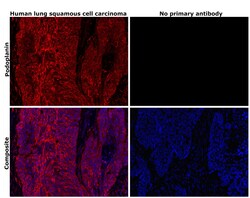
- Experimental details
- Immunohistochemical analysis of Podoplanin was performed using formalin-fixed paraffin-embedded human lung squamous cell carcinoma tissue sections. To expose the target protein, heat-induced epitope retrieval was performed on de-paraffinized sections using eBioscience™ IHC Antigen Retrieval Solution - High pH (10X) (Product # 00-4956-58) diluted to 1X solution in water in a decloaking chamber at 110 degree Celsius for 15 minutes. Following antigen retrieval, the sections were blocked with 2% normal goat serum for 1 hour at room temperature and then probed with or without Podoplanin Monoclonal Antibody (NZ-1.3), eBioscience™ (Product # 14-9381-82) at 5 µg/mL in 0.1% normal goat serum overnight at 4 degree Celsius in a humidified chamber. Detection was performed using Donkey anti-Rat IgG (H+L) Highly Cross-Adsorbed Secondary Antibody, Alexa Fluor™ Plus 647 at a dilution of 1:2,000 in 0.1% normal goat serum for 45 minutes at room temperature. ReadyProbes™ Tissue Autofluorescence Quenching Kit (Product # R37630) was used to quench autofluorescence from the tissues. Nuclei were stained with DAPI (Product # D1306) and the sections were mounted using ProLong™ Glass Antifade Mountant (Product # P36984). The images were captured on EVOS™ M7000 Imaging System (Product # AMF7000) at 20X magnification and externally deconvoluted.
- Submitted by
- Invitrogen Antibodies (provider)
- Main image
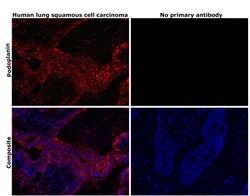
- Experimental details
- Immunohistochemical analysis of Podoplanin was performed using formalin-fixed paraffin-embedded human lung squamous cell carcinoma tissue sections. To expose the target protein, heat-induced epitope retrieval was performed on de-paraffinized sections using eBioscience™ IHC Antigen Retrieval Solution - Low pH (10X) (Product # 00-4955-58) diluted to 1X solution in water in a decloaking chamber at 110 degree Celsius for 15 minutes. Following antigen retrieval, the sections were blocked with 2% normal goat serum for 1 hour at room temperature and then probed with or without Podoplanin Monoclonal Antibody (NZ-1.3), eBioscience™ (Product # 14-9381-82) at 5 µg/mL in 0.1% normal goat serum overnight at 4 degree Celsius in a humidified chamber. Detection was performed using Donkey anti-Rat IgG (H+L) Highly Cross-Adsorbed Secondary Antibody, Alexa Fluor™ Plus 647 at a dilution of 1:2,000 in 0.1% normal goat serum for 45 minutes at room temperature. ReadyProbes™ Tissue Autofluorescence Quenching Kit (Product # R37630) was used to quench autofluorescence from the tissues. Nuclei were stained with DAPI (Product # D1306) and the sections were mounted using ProLong™ Glass Antifade Mountant (Product # P36984). The images were captured on EVOS™ M7000 Imaging System (Product # AMF7000) at 20X magnification and externally deconvoluted.
- Submitted by
- Invitrogen Antibodies (provider)
- Main image
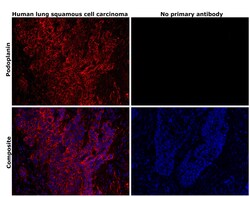
- Experimental details
- Immunohistochemical analysis of Podoplanin was performed using formalin-fixed paraffin-embedded human lung squamous cell carcinoma tissue sections. To expose the target protein, heat-induced epitope retrieval was performed on de-paraffinized sections using eBioscience™ IHC Antigen Retrieval Solution - Low pH (10X) (Product # 00-4955-58) diluted to 1X solution in water in a decloaking chamber at 110 degree Celsius for 15 minutes. Following antigen retrieval, the sections were blocked with 2% normal goat serum for 1 hour at room temperature and then probed with or without Podoplanin Monoclonal Antibody (NZ-1.3), eBioscience™ (Product # 14-9381-82) at 5 µg/mL in 0.1% normal goat serum overnight at 4 degree Celsius in a humidified chamber. Detection was performed using Donkey anti-Rat IgG (H+L) Highly Cross-Adsorbed Secondary Antibody, Alexa Fluor™ Plus 647 at a dilution of 1:2,000 in 0.1% normal goat serum for 45 minutes at room temperature. ReadyProbes™ Tissue Autofluorescence Quenching Kit (Product # R37630) was used to quench autofluorescence from the tissues. Nuclei were stained with DAPI (Product # D1306) and the sections were mounted using ProLong™ Glass Antifade Mountant (Product # P36984). The images were captured on EVOS™ M7000 Imaging System (Product # AMF7000) at 20X magnification and externally deconvoluted.
- Submitted by
- Invitrogen Antibodies (provider)
- Main image
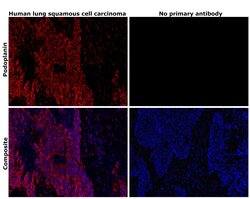
- Experimental details
- Immunohistochemical analysis of Podoplanin was performed using formalin-fixed paraffin-embedded human lung squamous cell carcinoma tissue sections. To expose the target protein, heat-induced epitope retrieval was performed on de-paraffinized sections using eBioscience™ IHC Antigen Retrieval Solution - High pH (10X) (Product # 00-4956-58) diluted to 1X solution in water in a decloaking chamber at 110 degree Celsius for 15 minutes. Following antigen retrieval, the sections were blocked with 2% normal goat serum for 1 hour at room temperature and then probed with or without Podoplanin Monoclonal Antibody (NZ-1.3), eBioscience™ (Product # 14-9381-82) at 5 µg/mL in 0.1% normal goat serum overnight at 4 degree Celsius in a humidified chamber. Detection was performed using Donkey anti-Rat IgG (H+L) Highly Cross-Adsorbed Secondary Antibody, Alexa Fluor™ Plus 647 at a dilution of 1:2,000 in 0.1% normal goat serum for 45 minutes at room temperature. ReadyProbes™ Tissue Autofluorescence Quenching Kit (Product # R37630) was used to quench autofluorescence from the tissues. Nuclei were stained with DAPI (Product # D1306) and the sections were mounted using ProLong™ Glass Antifade Mountant (Product # P36984). The images were captured on EVOS™ M7000 Imaging System (Product # AMF7000) at 20X magnification and externally deconvoluted.
Supportive validation
- Submitted by
- Invitrogen Antibodies (provider)
- Main image
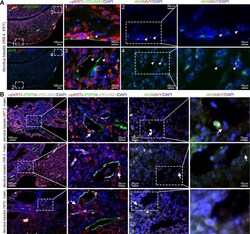
- Experimental details
- Fig 4 Human extravillous trophoblast cells invade decidual veins and lymphatics early during first trimester. (A) Histological sections of decidua basalis from a (mosaic) Klinefelter syndrome (47,XXY and 46, XY) pregnancy at W8.4. Left panels show low magnifications of same section immunostained for pKRT and PECAM1 (top) and chrX/chrY FISH (bottom). Middle-left and middle-right panels are magnifications of the (numbered) dashed boxes in the left panels. Right panels are magnifications of the dashed boxes in the middle-right panels. White arrowheads point to XXY fetal EVTs. (B) Histological sections of decidua basalis at W7.2, W8.4 and W10 immunostained for pKRT, PDPN and PECAM1 (left panels). FISH for chrX and chrY (right) was performed in the in the pKRT/PDPN/PECAM1-stained sections. White arrows point to EVTs invading the lymphatic vessels. All scale bars are depicted.
- Submitted by
- Invitrogen Antibodies (provider)
- Main image
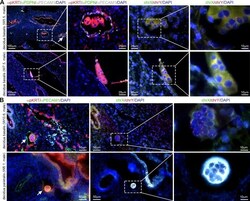
- Experimental details
- Fig 5 EVT aggregates and syncytial knots in the decidua basalis and parietalis. (A) Histological sections of decidua basalis at W5.5 and W7.5 immunostained for pKRT, PDPN and PECAM1 (lefts panels) showing the presence of mononuclear EVT aggregates (top row) and syncytial knots (bottom row). FISH for chrX and chrY (right panels) was performed in pKRT/PDPN/PECAM1-stained sections. White arrow indicates PDPN-positive lymphatics. (B) Histological sections of W10.6 decidua basalis (top row) and W8.1 decidua parietalis (bottom row) immunostained for pKRT and PECAM1 showing the presence of syncytial knots in veins. FISH for chrX and chrY (right panels) was performed in pKRT/PECAM1-stained sections. All scale bars are depicted.
- Submitted by
- Invitrogen Antibodies (provider)
- Main image
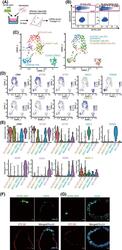
- Experimental details
- 1 FIGURE Identification of iAT1 cells in FD-AOs. A, A schematic representation of the analysis of scRNA-seq in FD-AOs. FD-EpCAM + cells (P2) were collected from two independent FD-AOs using FACS, followed by single-cell isolation using a Fluidigm C1 system and RNA sequencing. Bioinformatics data were processed using Seurat (version 3.1.2) including FD-SFTPC + cells (P2) (GSE90813). B, Flow cytometric analyses of FD-AOs (P2) with or without treatment with DMSO from day 2 to 14 before being subjected to scRNA-seq. C, UMAP plots displaying cell clusters of FD-EpCAM + cells (P2) in FD-AOs. We defined five major types of FD-EpCAM + cells: iAT1 cells, FD-iAT2 cells, mitotic cells, ASCL1 + PNECs, and NKX2-1 + cells. D, UMAP plots showing the expression of the selected marker genes; AT1 cells ( AGER , CAV1 , and PDPN ), AT2 cells ( SFTPB and SFTPC ), mitotic cells ( TOP2A ), ASCL1 + PNECs ( ASCL1 ), NKX2-1 + cells ( NKX2-1 ), and alveolar epithelial cells ( CPM ). E, Violin plots showing the gene expression distributions of the selected marker genes across cell types. F,G, Immunostaining of AT1 markers (HT1-56, PDPN, and AGER) and SFTPC-GFP in FD-AOs (P3). Scale bars = 10 mum. DMSO, dimethyl sulfoxide; FACS, fluorescence-activated cell sorting; FD-AOs, fibroblast-dependent alveolar organoids; scRNA-seq, single-cell RNA sequencing; UMAP, uniform manifold approximation and projection
- Submitted by
- Invitrogen Antibodies (provider)
- Main image
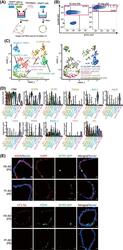
- Experimental details
- 2 FIGURE iAT1 cells are present in hiPSC-derived EpCAM + cell population in FD-AOs but poorly detected in FF-AOs. A, A schematic representation of the analysis of scRNA-seq in FD-AOs and FF-AOs. FD-EpCAM + cells (P0) and FF-EpCAM + cells (P0) were isolated using FACS. Next, scRNA-seq was performed and sequencing data, including that of FD-EpCAM + cells (P2), FD-EpCAM + /DMSO cells (P2), and FD-SFTPC + cells (P2), were analyzed. B, Flow cytometric analyses of FD-EPCAM + cells (P0) and FF-EpCAM + cells (P0) used for scRNA-seq. C, UMAP plots displaying cell clusters in FD-AOs and FF-AOs. We defined eight major types of hiPSC-derived EpCAM + cells: iAT1 cells, FD-iAT2 cells, mitotic cells, ASCL1 + PNECs, ID1 + cells, NKX2-1 + cells, gastric-like cells, and FF-EpCAM + cells. D, Violin plots showing the gene expression distributions of each representative marker gene. E, Immunostaining of AT1 markers (HT1-56, PDPN, and/or AGER) and SFTPC-GFP in the FD-AO (P3) and FF-AO (P0). Scale bars = 10 mum. DMSO, dimethyl sulfoxide; FACS, fluorescence-activated cell sorting; FD-AOs, fibroblast-dependent alveolar organoids; FF-AOs, fibroblast-free alveolar organoids; hiPSC, human induced pluripotent stem cell; scRNA-seq, single-cell RNA sequencing; UMAP, uniform manifold approximation and projection
- Submitted by
- Invitrogen Antibodies (provider)
- Main image
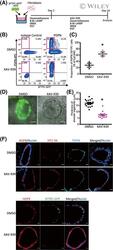
- Experimental details
- 6 FIGURE XAV-939 increases the population of iAT1 cells in FD-AOs. A, A schematic diagram of the analysis of the effect of XAV-939 on FD-AOs. B,C, Flow cytometric analyses of the PDPN and SFTPC expression of FD-EpCAM + cells (P2-5). FD-AOs (P2-5) were treated with 10 muM XAV-939 or DMSO from day 2 to 14, and then the proportion of SFPTC - PDPN + cells in FD-AOs was measured on day 14 (mean +- SEM, n = 3 from three independent experiments). The values indicate the percentage of each population. * P < .05 vs DMSO-treated hiPSC-derived SFTPC - PDPN + cells (unpaired two-tailed Student's t test). D,E, Representative bright-field and SFTPC-GFP fluorescence microscopic live cell images of FD-AOs (P2-5) treated with DMSO or 10 muM XAV-939 from day 2 to 14. Thickness of each FD-AO (P2-P5) treated with DMSO or 10 muM XAV-939 was measured (mean +- SEM, n = 18 spheres from three independent experiments). Scale bars = 50 mum. * P < .05 vs DMSO-treated FD-AO (unpaired two-tailed Student's t test). F, Immunostaining of AT1 markers (AGER, HOPX, HT1-56, and/or PDPN) and SFTPC-GFP in DMSO- or XAV-939-treated FD-AOs (P3). Scale bars = 10 mum. DMSO, dimethyl sulfoxide; FD-AOs, fibroblast-dependent alveolar organoids; hiPSC, human induced pluripotent stem cell
- Submitted by
- Invitrogen Antibodies (provider)
- Main image
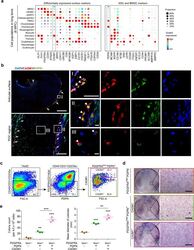
- Experimental details
- Fig. 4 Identification of CADM1 as a phenotypic marker of eSSPCs. a Dot plots showing the expression of differentially expressed cell surface genes (left) and candidate SSC markers (right) in 8 WPC human long bone subsets. Asterisks indicated positive markers that were used to enrich eSSPCs. b Immunofluorescent images of PDPN + CADM1 + cells in 8 WPC human long bones. Overviews of PDPN + CADM1 + cells (arrows) in the articular (upper left) and POC (bottom left) regions were shown on the left. PDPN + CADM1 + cells were found in the inner layer of perichondrium in the articular regions (I) and surrounding POC (II). A few PDPN + CADM1 + cells were also found inside POC (III). Arrow heads indicated enlarged PDPN + CADM1 + cells. Merged and single-channel images of DAPI (blue), CADM1 (red) and PDPN (green) were shown ( n = 2 embryos). Scale bars in snapshot images, 50 mum; scale bars in magnified images, 5 mum. c Flow cytometry gating strategies for sorting different populations in 8 WPC long bones ( n = 3 embryos). d Representative crystal violet staining of CFU-F colonies generated by the sorted populations as indicated in c . Magnified images of the boxed areas were shown on the right. Scale bars, 25 mum. e Quantifications of the number (left) and mean diameter (right) of the CFU-F colonies ( n = 3 embryos). The statistical significance of differences was determined using one-way ANOVA with multiple comparison tests (LSD). * P < 0.05; ** P < 0.01; *** P < 0.001. Error bars indic
- Submitted by
- Invitrogen Antibodies (provider)
- Main image
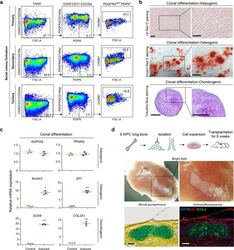
- Experimental details
- Fig. 5 Functional characterizations of eSSPCs in vitro and in vivo. a Flow cytometry plots showing the maintenance of phenotypic eSSPCs after serially passaging clonally expanded PDGFRA low/- PDPN + CADM1 + cells ( n = 3 clones). b Representative oil red O (top), alizarin red (middle) and toluidine blue (bottom) staining after adipogenic, osteogenic and chondrogenic differentiation of clonally expanded eSSPCs (PDGFRA low/- PDPN + CADM1 + ). Magnified images of the boxed areas were shown on the right. Scale bars, 200 mum. c qPCR analyses of adipogenic, osteogenic and chondrogenic marker genes in clonally expanded eSSPCs before and after trilineage differentiation in vitro ( n = 3 clones). The statistical significance of differences was determined using Wilcoxon signed rank test. * P < 0.05; ** P < 0.01. Error bars indicated SEM. d Renal subcapsular transplantation. The work flow for functional characterization of eSSPC in vivo (top). Subcapsular xenografts were dissected and sectioned 8 weeks after transplantation of culture expanded eSSPCs into immunodeficient mice. Bright field (middle), Movat pentachrome staining (bottom left; cartilage, blue; bone and fibrous tissue, yellow) and immunofluorescent staining images (bottom right; DAPI, blue; collagen I (COL1), red; collagen II (COL2), green) were shown ( n = 9 grafts from three embryos). Scale bars, 50 mum.
- Submitted by
- Invitrogen Antibodies (provider)
- Main image
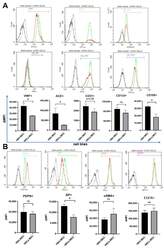
- Experimental details
- Figure 2 Characterization of ECs by flow cytometry markers. The cells were stained for the following markers: VWF, ACE, CD31, CD34, CD133, CD105, PDPN, AP, alphaSMA, EGFR. Data were recorded for 10,000 events using CellQuest software (v.2.3.0.84) and presented as histogram overlays. ( A ) The most characteristic markers for ECs and EPCs. ( B ) Markers associated with cancerous phenotype. Histogram overlays display representative repetitions; gray--healthy ECs unstained, black--tumor ECs unstained, green--healthy ECs stained, red--tumor ECs stained. Y axis = the number of events; X axis = fluorescence intensity; the bar charts present delta MFI. Ns--not significant; * p < 0.05 in Student t test vs. HBH.MEC. Data are reported as the means +- SEM (n = 3).
- Submitted by
- Invitrogen Antibodies (provider)
- Main image
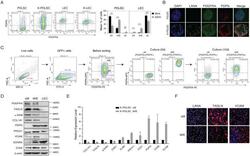
- Experimental details
- 10.1371/journal.ppat.1009600.g005 Fig 5 Characterization of KSHV-infected PDLSCs of distinct states in the mesenchymal-to-endothelial differentiation spectrum. (A) Mock- and KSHV-infected PDLSCs and LECs were examined for PDGFRA and PDPN expression profile by flow cytometry analysis. Three subpopulations (xM, hybrid M/E, and xE) were quantified based on the PDGFRA and PDPN profiles ( n = 3 independent experiments). Statistical analyses were performed using two-tailed Student's test and P-values were calculated by GraphPad Prism. *p < 0.05, **p < 0.01, ***p < 0.001. ( B) PDGFRA and PDPN expression in PDLSC and K-PDLSC spheroids at 4 days post-infection were analyzed by IFA. Scale bar, 50 mum. ( C) K-PDLSCs were stained for PDGFRA and PDPN and sorted by flow cytometry. The purified xM and M/E populations were cultured for 10 days and their PDGFRA/PDPN profiles were examined for their phenotypic plasticity. ( D) Western blot analysis of xM, M/E, and LECs for their mesenchymal and endothelial markers. ( E) The expression profiles of mesenchymal and endothelial markers in hybrid M/E and xM state cells were analyzed at the mRNA level by RT-qPCR. ( F) IFA analysis of LANA, TAGLN, and VCAM in xM and M/E state cells. Scale bar, 50 mum.
- Submitted by
- Invitrogen Antibodies (provider)
- Main image
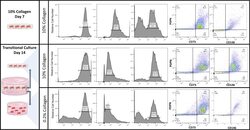
- Experimental details
- Cell surface analysis of AMSCs within the transitional culture AMSCs were cultured in a 10% collagen type I gel for 7 days and embedded in a 0.2% collagen type I gel, making up the transitional culture for an additional 14 days. Flow cytometric analysis was conducted for PDPN, CD73, and CD146 (representative data presented).
 Explore
Explore Validate
Validate Learn
Learn Western blot
Western blot Immunoprecipitation
Immunoprecipitation Immunohistochemistry
Immunohistochemistry